|
| |
Archives
that's all folks
At least for now. A busy week coming up.
food
FDA Rules Override Warnings About Drug
Cattle Antibiotic Moves Forward Despite Fears of Human Risk
|
The government is on track to approve a new antibiotic to treat a pneumonia-like disease in cattle, despite warnings from health groups and a majority of the agency's own expert advisers that the decision will be dangerous for people.
The drug, called cefquinome, belongs to a class of highly potent antibiotics that are among medicine's last defenses against several serious human infections. No drug from that class has been approved in the United States for use in animals.
The American Medical Association and about a dozen other health groups warned the Food and Drug Administration that giving cefquinome to animals would probably speed the emergence of microbes resistant to that important class of antibiotics, as has happened with other drugs. Those super-microbes could then spread to people.
Echoing those concerns, the FDA's advisory board last fall voted to reject the request by InterVet Inc. of Millsboro, Del., to market the drug for cattle.
Yet by all indications, the FDA will approve cefquinome this spring. That outcome is all but required, officials said, by a recently implemented "guidance document" that codifies how to weigh the threats to human health posed by proposed new animal drugs.
| |
[more]
Dangerous New Medicines For Enslaved Cows That Are Dying From Abuse
|
Industrial farming is a disaster. The 'green' revolution is now undergoing a reactionary surge brought on by Mother Nature who uses her handy tool, 'natural selection.' Corporations think they have outwitted Her Majesty but instead, they play the Fool. Today's news is about a super-powerful anti-bacterial medicine for cows. This will make things much, much worse.
| |
[more]
book recommendation

Third Views, Second Sights:
A Rephotographic Survey of the American West
by Mark Klett
This is the first book of a trio of rephotography books by Mark Klett. I've already recommended the first two books: Yosemite in Time: Ice Ages, Tree Clocks, Ghost Rivers and After the Ruins, 1906 and 2006: Rephotographing the San Francisco Earthquake and Fire. Klett's original rephotography project was done in the late 1970s. He, and a team of others, took photographs done by the western survey photographers, William Henry Jackson, T. H. O’Sullivan, and William Bell, in the 1880s and located the precise location, time of year, and time of day and retook the photographs. This resulted in a book titled Second Views that has been out of print for some time. The book showed both sets of photographs. Twenty years later Klett did it again resulting in three views. This time he included other media and those, and all the photographs, are also available on a website.
Third 3 View
|
Third View revisits the sites of historic western American landscape photographs. The project makes new photographs, keeps a field diary of its travels, and collects materials useful in interpreting the scenes, change and the passage of time.
The Third View project began in 1997 and completed fieldwork in the year 2000. Over the course of four years the project revisited 109 historic landscape sites, all subjects of nineteenth-century American western survey photographs. The project’s "rephotographs" were made from the originals’ vantage points with as much precision as possible. Every attempt was also made to duplicate the original photographs' lighting conditions, both in time of day and year.
Most sites are represented in a series of three views taken at different times. The original photographs were taken by photographers such as Timothy O’Sullivan, William Henry Jackson, John K. Hillers, and William Bell. The photographs were made for the western geological and geographical surveys of the 1860’s and ‘70’s. These surveys were lead by Ferdinand V. Hayden, Clarence King, Lt. George Wheeler, and Major John Wesley Powell. The survey photographs were typically the earliest to be made in the American West, and form the baseline of an important visual record. The pictures are benchmarks for monitoring physical changes in the land as well as providing access into the earliest ways land and culture were represented by photography.
| |
Location
Pyramid Isle, Pyramid Lake, Nev.
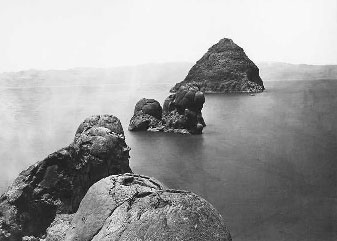
First View
Timothy O'Sullivan, 1867. Rock formations, Pyramid Lake, Nev. (Massachusetts Institute of Technology.)
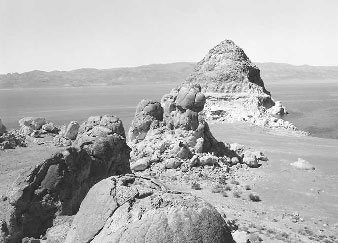
Second View
Mark Klett for the Rephotographic Survey Project, 1979. Pyramid Isle, Pyramid Lake, Nev.
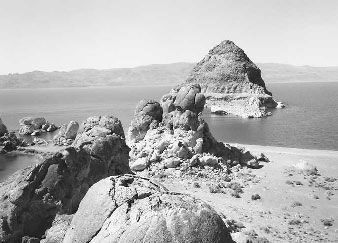
Third View
Mark Klett and Byron Wolfe for the Third View Project, 2000. Pyramid Isle, Pyramid Lake, Nev.
[more]
The book, unfortunately, is not available from my local library system but I got it on an interlibrary loan. The book comes with a DVD of what is on the website. There are also instructions on how to locate exact locations from the original photograph. When I get the 5x7 together, I want to do documentary pictures around the south end of Whidbey Island. Some of that will have to include some rephotographs. This is just too cool.
energy
Saudi Arabian oil declines 8% in 2006
|
Overall, I feel this data is clear enough that I'm willing to go out on a limb and conclude the following:
Saudi Arabian oil production is now in decline.
The decline rate during the first year is very high (8%), akin to decline rates in other places developed with modern horizontal drilling techniques such as the North Sea.
Declines are rather unlikely to be arrested, and may well accelerate.
[...]
I suggest that this is likely to place severe political strains on Saudi Arabia within a year or two at most.
| |
[more]
The Ethanol Scam
Food or Fuel?
|
The ethanol scam just keeps getting more and more absurd. In January, three U.S. senators two Democrats, Tom Harkin of Iowa and Barack Obama of Illinois, along with Indiana Republican Richard Lugar introduced a bill that would promote the use of ethanol. It also mandates the use of more biodiesel and creates tax credits for the production of cellulosic ethanol. They called their bill the "American Fuels Act of 2007."
The most amazing part of the press release trumpeting the legislation is its fourth paragraph, in which Lugar declares that "U.S. policies should be targeted to replace hydrocarbons with carbohydrates."
Let's consider that for a moment. In the 18th and 19th centuries, the U.S. economy was primarily based on carbohydrates. For most people, horses were the main mode of transportation. They were also a primary work source for plowing and planting. Aside from coal, which was used by the railroads and in some factories, the U.S. economy depended largely on the ability of draft animals to turn grass and forage into usable toil. America's farmers were solely focused on producing food and fiber. And while the U.S. was moderately prosperous, it was not a world leader.
Oil changed all that. After the discovery of vast quantities of oil in Texas, Oklahoma, and other locales, America was able to create a modern transportation system, with cars, buses, and airplanes. That oil helped the U.S. become a dominant military power. Humans were freed from the limitations of the carbohydrate economy, which was constrained by the amount of arable land.
Thus while Lugar and his ilk promote ethanol, they are ignoring a pivotal question: should our farms produce food or fuel?
Last September, Lester Brown, the president of the Earth Policy Institute (a group that promotes "an environmentally sustainable economy") wrote in a Washington Post opinion piece that the amount of grain needed to make enough ethanol to fill a 25-gallon SUV tank "would feed one person for a full year. If the United States converted its entire grain harvest into ethanol, it would satisfy less than 16 percent of its automotive needs." Brown said the ongoing ethanol boom in the U.S. was "setting the stage for an epic competition. In a narrow sense, it is one between the world's supermarkets and its service stations." More broadly, "it is a battle between the world's 800 million automobile owners, who want to maintain their mobility, and the world's 2 billion poorest people, who simply want to survive."
| |
[more]
photography
Panoramas of WWII Landmarks
Hiroshima Dome
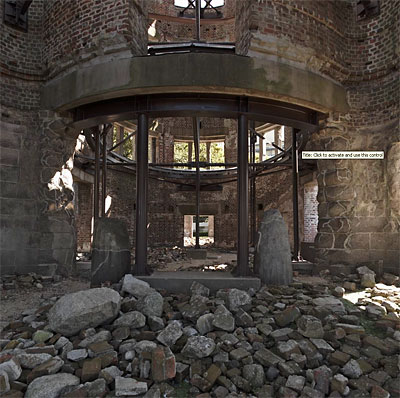
[more]
thanks to Neatorama
change is coming — maybe
Was 2006 a Turning-Point Election?
|
All media eyes have turned toward the presidential election of 2008. Like the headlights of an onrushing train, it mesmerizes. Every news bulletin about the latest bloodbath in Iraq, each ominous forewarning of a face-off with Iran, the endless dirge of abandonment and despair issuing from New Orleans, the daily register of those cut loose from any semblance of a social safety net, public or private, each new official confirmation that the Earth is reaching a boiling point compels us to anticipate the 2008 election with fear and trembling, and with the greatest expectations. Something momentous might happen then. Haven't we already seen the first signs of that in the extraordinary electoral outcome of November 2006?
| |
[more]
sculpture
The Art of Keisuke Kishi

[more]
thanks to Neatorama
economy
The Second Great Depression
Crashing to Earth
|
This week's data on the sagging real estate market leaves no doubt that the housing bubble is quickly crashing to earth and that hard times are on the way. "The slump in home prices from the end of 2005 to the end of 2006 was the biggest year over year drop since the National Association of Realtors started keeping track in 1982." (New York Times) The Commerce Dept announced that the construction of new homes fell in January by a whopping 14.3%. Prices fell in half of the nation's major markets and "existing home sales declined in 40 states". Arizona, Florida, California, and Virginia have seen precipitous drops in sales. The Commerce Department also reported that "the number of vacant homes increased by 34% in 2006 to 2.1 million at the end of the year, nearly double the long-term vacancy rate." (Marketwatch)
The bottom line is that inventories are up, sales are down, profits are eroding, and the building industry is facing a steady downturn well into the foreseeable future.
The ripple effects of the housing crash will be felt throughout the overall economy; shrinking GDP, slowing consumer spending and putting more workers in the growing unemployment lines.
Congress is now looking into the shabby lending practices that shoehorned millions of people into homes that they clearly cannot afford. But their efforts will have no affect on the loans that are already in place. $1 trillion in ARMs (Adjustable Rate Mortgages) are due to reset in 2007 which guarantees that millions of over-leveraged homeowners will default on their mortgages putting pressure on the banks and sending the economy into a tailspin. We are at the beginning of a major shake-up and there's going to be a lot more blood on the tracks before things settle down.
| |
[more]
Maybe We Deserve to Be Ripped Off By Bush's Billionaires
While America obsessed about Brittany's shaved head, Bush offered a budget that offers $32.7 billion in tax cuts to the Wal-Mart family alone, while cutting $28 billion from Medicaid.
photography
This is a site of a professional photographer that likes to tinker a bit.
John Siskin
One of his projects puts an Arsat Kodiak 30mm lens used on a Salut-S on a 4x5 Speed Graphic making it a large format fisheye. I've wanted one of those lenses for my Salut-S but, where they used to be plentiful and could be had for $165, they are hard to find and are up around $250. Bummer. It could have be fun. But the project of his I'm interested in (Blaine, are you paying attention?) is where he assembles diopter lenses in a tin can, mounts them on a shutter, and has a soft focus portrait lens. The thing with old soft focus portrait lenses is that they are not just soft focus but they do glowy things to specular highlights. Soft focus portrait lenses are hard to find for under $300. I'm sure diopters can be had for less. I'm sure Blaine has lots of these diopters laying around.
Hand-Assembling Lenses for the View Camera

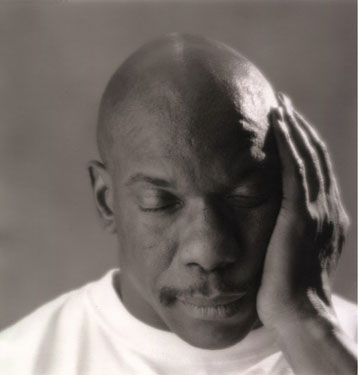
[more]
And do check out his magazine articles.
global climate change
The end of the West as we know it?
|
Every political, social and economic system ever created has sooner or later encountered a challenge that its very nature has made it incapable of meeting. The Confucian ruling system of imperial China, which lasted for more than 2,000 years, has some claim still to be the most successful in history, but because it was founded on values of stability and continuity, rather than dynamism and inventiveness, it eventually proved unable to survive in the face of Western imperial capitalism.
For market economies, and the Western model of democracy with which they have been associated, the existential challenge for the foreseeable future will be global warming. Other threats like terrorism may well be damaging, but no other conceivable threat or combination of threats can possibly destroy our entire system. As the recent British official commission chaired by Sir Nicholas Stern correctly stated, climate change "is the greatest and widest-ranging market failure ever seen."
The question now facing us is whether global capitalism and Western democracy can follow the Stern report's recommendations, and make the limited economic adjustments necessary to keep global warming within bounds that will allow us to preserve our system in a recognizable form; or whether our system is so dependent on unlimited consumption that it is by its nature incapable of demanding even small sacrifices from its present elites and populations.
If the latter proves the case, and the world suffers radically destructive climate change, then we must recognize that everything that the West now stands for will be rejected by future generations. The entire democratic capitalist system will be seen to have failed utterly as a model for humanity and as a custodian of essential human interests.
[...]
If this comes to pass, what will our descendants make of a political and media culture that devotes little attention to this threat when compared with sports, consumer goods, leisure and a threat from terrorism that is puny by comparison? Will they remember us as great paragons of human progress and freedom? They are more likely to spit on our graves.
Underlying Western free-market democracy, and its American form in particular, is the belief that this system is of permanent value to mankind: a "New Order of the Ages," as the motto on the U.S. Great Seal has it. It is not supposed to serve only the short- term and selfish interests of existing Western populations. If our system is indeed no more than that, then it will pass from history even more utterly than Confucian China — and will deserve to do so.
| |
[more]
thanks to The Washington Note
Climate change: scientists warn it may be too late to save the ice caps
|
A critical meltdown of ice sheets and severe sea level rise could be inevitable because of global warming, the world's scientists are preparing to warn their governments. New studies of Greenland and Antarctica have forced a UN expert panel to conclude there is a 50% chance that widespread ice sheet loss "may no longer be avoided" because of greenhouse gases in the atmosphere.
| |
[more]
Tomgram: McKibben, The Real News about Global Warming
|
The world is, it seems, melting like an ice cream cone in the sun. Let me leave it at that.
As all Tomdispatch readers know, I write the introductions to posts at this site. This post is undoubtedly the exception that proves the rule. The editors of The New York Review of Books have been kind enough to let me put out Bill McKibben's striking essay on the real news lurking in the latest major report on global warming. (His piece appears in the March 15 issue of the magazine, now on the newsstands.) McKibben whose new book, Deep Economy: The Wealth of Communities and the Durable Future, is about to be published (and eagerly awaited by me), has been involved in important recent organizing efforts re: climate change. So I decided to give him the first -- and last -- word today. Tom
Bill McKibben: "This piece is an account of a scientific triumph -- the ongoing effort to understand and warn about climate change in a timely fashion -- and also, of course, of a political debacle -- the complete failure of our government over two decades to address the problem in any fashion whatsoever. But it ends with a paragraph about an effort now five weeks old and, so far, entirely confined to the Web. When we launched stepitup07.org in mid-January, we hoped we might be able to find a couple of hundred groups and individuals around the country who would agree to hold rallies on April 14.
"That would have represented by far the largest demonstration against global warming in U.S. history. By this point, our wildest imaginings have been long since surpassed -- we're nearing 700 actions scheduled for April 14, and the sheer genius people have brought to designing some of them boggles the mind. There will be underwater demonstrations, rallies on top of mountains, and on and on. All of it makes me think of the example and the words of Rebecca Solnit on Tomdispatch.com in recent years: As far as I can tell, she's absolutely right in her confidence that people around the country and around the world can, joyfully and powerfully, rise to the challenges in front of us. People power is a lovely thing to behold!"
| |
[more]
photography
Dylan Chatain
Photographs

[more]
thanks to Conscientious
iran
The Road Not Taken
|
This is from Vice: Dick Cheney and the Hijacking of the American Presidency, by Lou Dubose and Jake Bernstein. Lawrence Wilkerson was former Secretary of State Colin Powell’s chief of staff.
In May 2003 the Iranian government approached the U.S. government with an urgent request to open up negotiations. There had been only one other official communication between Iran and the United States since Iranian radicals seized the U.S. embassy in Tehran during the Carter administration. Now the initial U.S. success in Iraq had the Iranians coming to the bargaining table as supplicants.
“The Iranians came to us through the Swiss ambassador after they saw how fast we moved through Afghanistan and Iraq,” Wilkerson says. “This was in 2003, right after [the invasion of] Iraq.” Mahmoud Ahmadinejad was not yet president and the moderates in charge in Iran wanted to deal.
The letter delivered by Swiss ambassador Tim Guldimann offered concessions on Iran’s nuclear program, Israel policy, and al-Qaeda. “Israel policy,” of course, involved Tehran’s support of Hezbollah. According to Wilkerson, the Iranians offered to exchange al-Qaeda prisoners they held for Mujahedeen e Khalq prisoners the United States had in custody. The MEK was a guerrilla group Saddam Hussein had used in his war against Iran. After the war they engaged in terrorist attacks against Iran and are designated terrorists by the U.S. State Department.
More than a hundred billion dollars, thousands of American and Iraqi lives, America’s allies’ unflagging opposition to the war, and a deeply divided public. Finally it was all paying off. One of the countries Bush had placed in the Axis of Evil was coming in out of the cold.
“We told them no,” Wilkerson says in an interview at George Washington University. “Not only did we tell them no — we wrote a letter of protest to the Swiss for interfering in our foreign policy.”
The entire diplomatic endeavor was immediately curtailed. Asked if he knows who made the decision to reject the Iranian request for negotiations, Larry Wilkerson didn’t miss a beat.
“Yes, I know,” he says. “It was the vice president of the United States.” | |
[more]
US 'Iran attack plans' revealed
|
It is understood that any such attack - if ordered - would target Iranian air bases, naval bases, missile facilities and command-and-control centres.
| |
[more]
Israel seeks all clear for Iran air strike
|
Israel is negotiating with the United States for permission to fly over Iraq as part of a plan to attack Iran's nuclear facilities, The Daily Telegraph can reveal.
| |
[more]
US funds terror groups to sow chaos in Iran
|
America is secretly funding militant ethnic separatist groups in Iran in an attempt to pile pressure on the Islamic regime to give up its nuclear programme.
| |
[more]
It's Not The Iranians . . .
|
. . . who are funding the war against American troops in Iraq. It's the Saudis.
I even said as much in my short segment on the Chris Duel Show the day before yesterday.
Over 90% of American casualties come at the hands of the Sunnis, not Shi'a. Who funds the Sunnis? The Saudis. 15 of the 19 hijackers on September 11 were from Saudi Arabia. We're fighting against Salafist inspired Wahhabi Jihadis.
Not the Shi'a.
| |
[more]
photography
These are pictures taken by a soldier in Iraq who uses Leicas.
tightsqueez's photos
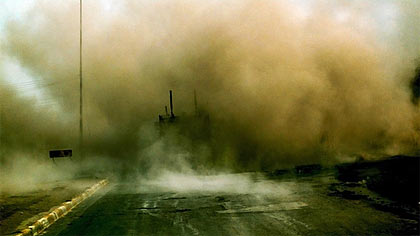
The Buffalo seconds after being hit by an IED. Iraq. December 2006.
|
Currently on my 2nd Iraq deployment. My pictures can describe my job better than words...so I'll leave it at that.
For those of you who are wondering what I use, it is nothing but Leica. They are simple, reliable and can take what war throws at them. While quite expensive, they give back doing what they were intended for; recording history.
My use list.
M6
M7
M8
Elmarit-M 1:2.8/24 ASPH
Summicron-M 1:2/28 ASPH
Summicron-M 1:2/35
Summilux-M 1:1.4/35 ASPH
Summicron-M 1:2/50
Summicron-M 1:2/75 ASPH APO
...and last but not least, D-Lux 3
| |
[more]
thanks to RangefinderForum.com
|
|
|
|











